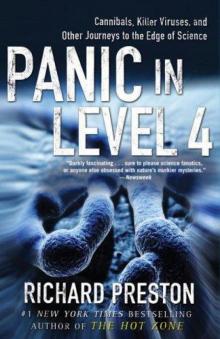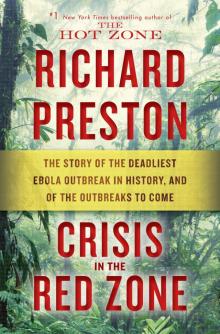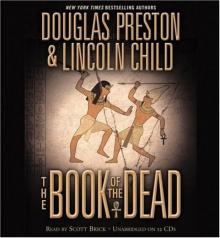- Home
- Richard Preston
Crisis in the Red Zone Page 8
Crisis in the Red Zone Read online
Page 8
“Humarr, how are you?” Sabeti asked. “I’m worried about you. I’m worried Ebola could get to Sierra Leone.”
Khan said he was worried, too. The Lassa program’s Hot Lab was the only high-biocontainment laboratory anywhere across an extended region of West Africa. The first principle of warfare against an emerging virus is to know where it is moving. Yet Humarr Khan had no lab machines that could identify Ebola virus in human blood. If Ebola crossed the river and entered Sierra Leone, Khan and his team would need to be able to identify people who were carrying Ebola. If infected people could be identified, then they could be isolated inside the Lassa ward and cared for by specially trained nurses wearing hazmat gear. This would stop the virus from getting into other people, and it would break the chains of infection.
Sabeti offered Khan a special device known as a PCR machine. It could detect the genetic code of Ebola in human blood, and so it could be used to test patients’ blood. She said she’d send him one immediately, along with people who could train Khan’s Hot Lab staff in how to use it.
After talking with Khan, Sabeti went out of her office, shutting the door behind her so her rat wouldn’t get loose, and she drove to the Broad Institute, which occupies a pair of crystalline buildings in Kendall Square next to the MIT campus. About four thousand scientists work regularly at the Broad, where they decode and analyze the genomes of organisms. At her offices on the sixth floor, Sabeti called a meeting with a few people, a group that would grow in size and would be known as the Ebola War Room Team. They began planning and directing elements of the human defense against Ebola. Sabeti raided her Harvard lab budget for $600,000 worth of equipment, lab supplies, and cash. By the end of the day, she had given two of her colleagues, Kristian Andersen and Stephen Gire, the assignment of taking the stuff to Kenema and setting up an Ebola blood lab for Humarr Khan. Andersen and Gire made preparations to depart for West Africa as soon as possible.
INTEGRATED RESEARCH FACILITY
FREDERICK, MARYLAND
Next day, March 25
Humarr Khan had been reading up on Ebola, and it alarmed him. The day after he spoke with Pardis Sabeti, he talked with a scientist named Joseph Fair, who was then working for an American biotech firm called Metabiota. Khan and Fair were close friends and drinking buddies, and Khan had once saved Joseph Fair’s life. Fair offered to set up a blood lab for Khan in Kenema, and Khan said sure, absolutely. Pardis Sabeti was sending him a blood lab, too, but he wanted to play it safe.
As soon as he had made plans with Khan, Joseph Fair reached out to his friend Lisa Hensley at the IRF. He asked her if she’d like to come with him to Kenema and help set up the lab for Khan. Hensley knew Khan pretty well. She had gone to Kenema with Fair once before, and the two scientists had worked together setting up a Lassa blood-testing lab for Khan.
Lisa Hensley liked Humarr Khan, and the idea of helping in the Ebola outbreak still really intrigued her. She went back to her boss, Peter Jahrling, and asked him if she could get a short leave of absence from the IRF so that she could travel to Kenema and help Khan. “I can do this,” she said to Jahrling.
“I couldn’t argue with Lisa this time,” Jahrling now says. He knew Humarr Khan, too, and liked him. He contacted his boss at the NIH, and they worked out a deal: The NIH would loan Lisa Hensley to the U.S. Department of Defense for a three-week military deployment to Kenema Government Hospital. Hensley was a civilian, but while she was in Africa she would be operating inside the U.S. military chain of command.
Hensley soon received a letter from Humarr Khan:
Dear Dr. Hensley,
It is with great pleasure I write to invite you to help with your expertise on epidemic preparedness and outbreak response on Ebola fever….The very long border we are sharing with Guinea increase[s] the susceptibility of a possible import of this disease to our country.
Meanwhile, Pardis Sabeti’s scientists had already arrived in Kenema, and they quickly finished setting up their blood-testing equipment in the Lassa program’s Hot Lab.
At this point, the U.S. military changed Hensley’s deployment orders. She had to go where the military sent her, and she was assigned to Monrovia, the capital of Liberia, to set up an Ebola blood-testing lab for the government of Liberia. Several cases of Ebola had been reported in that country. She wouldn’t be going to Kenema; she wouldn’t be working with Humarr Khan after all.
Hensley and Joseph Fair went into the supply storerooms of the IRF, as well as the storerooms at USAMRIID, and they began assembling all the elements of a portable space-suit lab for testing blood. They began packing everything into military trunks for air shipment to Liberia. One evening, when Hensley was at home and putting her personal things into a duffle bag, James offered to help her pack. He went into her closet and got out a wide-brimmed beach hat and stuffed it into her duffel bag. “You need a hat so you won’t get sunburned in Africa,” he said.
It was just around then that Menindor the healer, the sage with almond eyes who kept a magic snake in her house, fell sick in Kpondu village. As Hensley packed for Africa, Menindor lay in bed in her house in Kpondu, with vomiting and diarrhea, while her elderly mother and her sister cared for her. For the many people who depended on Menindor and cherished her, her illness must have been a frightening thing to see. It seemed that not even Menindor’s powers could overcome the evil force of the sickness that was visiting the villages of Sierra Leone.
SURVEILLANCE
KENEMA, SIERRA LEONE
Last week of March
A hundred miles from Menindor’s village, Dr. Humarr Khan, at Kenema Government Hospital, had seen no reports of Ebola in Sierra Leone. The virus was active in Guinea, just across the Makona River. He worried that the virus could cross the river, traveling inside a person, and could start spreading through villages in Sierra Leone. The Lassa program had a team of epidemiologists, called a surveillance team. The team traveled in bush ambulances, for carrying suspected Lassa patients back to the Kenema hospital, where they would be placed in the Lassa ward if they tested positive for Lassa.
Khan met with the surveillance team in a room called the Library, which is in the Lassa Laboratory. There weren’t many books in the Library, but it had a couple of tables and an Internet connection that sometimes worked. Khan told the team that it was going to be hard to distinguish Ebola disease from Lassa fever. Both viruses produce similar symptoms—diarrhea, vomiting, extreme pain, bleeding from the orifices, shock or coma, death. If the surveillance team found anybody showing Ebola-like signs, the person was to be fitted inside a hazmat suit, to protect the team members from infection, and taken by ambulance back to the Kenema hospital, where the patient’s blood would be tested for Ebola as well as for Lassa.
The surveillance team visited villages along the Makona River, asking questions, describing the symptoms of Ebola, and looking for anybody who might have it. They came up empty-handed. The villagers said they hadn’t seen this disease.
The Kenema surveillance team was being advised by an American scientist named Lina M. Moses. A lively woman in her thirties, Moses was a postdoctoral researcher at the Tulane School of Public Health and Tropical Medicine, in New Orleans. She was an expert in infectious disease ecology, which is the study of the way ecosystems, viruses, and people interact. Each year, Moses lived in Kenema for several months, doing research. She spoke Krio, one of the two national languages of Sierra Leone (the other one is English). She also spoke some Mende, an ethnic language. When Moses was stationed in Kenema, she spent time in the countryside, trapping rats and testing their blood for Lassa virus, watching the virus’s hidden movements in the ecosystem and through people.
In 2011, a molecular biologist named Erica Saphire visited the Kenema hospital, where she met Lina Moses for the first time. “My impression was of a sweaty, dirty young woman, with dark hair and an expressive face,” Saphire recalls. “She was wearing a work
shirt, jeans, and hiking boots, and she was carrying a plastic bucket full of dead rats. The rats were floating in a liquid that looked like the beginnings of a Cajun gumbo,” Saphire says. Lina Moses’s rat gumbo was hot enough to frighten Army scientists at Fort Detrick. Saphire had immediately liked Moses.
Moses began meeting frequently with the surveillance team in the Library. She gathered their reports and made recommendations for where they should go next. She thought about where Ebola could be hiding in Sierra Leone, if, in fact, it had crossed the river. She spread out maps of eastern Sierra Leone on the table in the Library and studied them. Moses knew the territory fairly well.
But her knowledge of the countryside was partly in her head. The maps of the Makona Triangle aren’t reliable. The landscape is dotted with tiny villages, typically spaced a few hundred yards apart. Different villages often have similar or identical names. In Krio the same word can often be spelled several different ways. Therefore the name of a village could appear under several different spellings on different maps. Furthermore, many villages were just a dot on the map—no name at all. And there were uncharted villages, small communities that didn’t appear on any map. Some of them were reachable only on footpaths.
Lina Moses made calls to community health clinics in and near the Makona Triangle. She told the clinic managers about Ebola and asked if they’d seen any patients with the symptoms. She also called district medical officers and asked them to track down reports of suspicious illnesses. The Lassa surveillance team visited villages, gave the local people information about Ebola, and asked them if they’d heard of anybody with an illness like it. The surveillance team and Lina Moses came up empty-handed. The local people were saying that they hadn’t seen anything like Ebola disease.
GUINEA
Last days of March
On the Guinea side of the river, staffers and health workers with Doctors Without Borders were identifying Ebola patients and placing them in the red zones of tented camps, where the patients were given care according to the rules of Doctors Without Borders. Those who died in the red zone were buried near the camp. As the virus continued to spread, local people got increasingly fearful of the Doctors’ treatment units. The camps, with their white tents, had a sinister look, and they were being run by white foreigners. The foreigners were telling people that they were infected with a virus and must go into the camp, and those people were vanishing in the camps, never to be seen again. Foreigners dressed in moon suits were carrying white bags with dead bodies inside them out of the camps and burying them next to the camp. Nobody was allowed to open the bag and look inside at the loved one, because the foreigners said the corpse was dangerous.
People in the Makona Triangle had never heard of Ebola. Many people didn’t believe in the infectious theory of disease—the idea that diseases are caused by invisible microbes. Plenty of people in Kissi country had mobile phones, and they used social media to discuss the situation. Text messages started flying around the Makona Triangle, rumors about the camps. The white foreigners, went the rumors, were injecting chlorine into people and doing hideous experiments on their bodies.
A doctor named Armand Sprecher, who is a public health expert at Doctors Without Borders, later explained to me that the Doctors’ Ebola treatment centers always awakened fear in local populations. “In every Ebola outbreak we were seen as strange people in strange clothes carrying out experiments on poor Africans, or harvesting organs,” Sprecher said. “We were supposed to be profiting in some way. People have thrown plenty of stones at us.”
If a group of powerful foreigners who spoke no English, or spoke it badly with a heavy accent, were to set up a camp of tents in suburban Wellesley, Massachusetts, and they were wearing biohazard moon suits and were telling townspeople that an extreme virus had gotten loose in Wellesley and that anybody who had symptoms must go into the camp and stay there until they died, there might be some opposition from the Wellesleyites. And if most people who went into the camp were never seen again, dead or alive, and if the foreigners were burying white body bags next to the camp, and if quite a few of the bags obviously held dead children, and if social media lit up with rumors of hideous experiments, it’s a pretty sure bet that the Wellesleyites would be reaching for their guns and doing anything they could to get the hell out of Wellesley. “It’s your darkest nightmare,” Armand Sprecher explained.
By March 31—just a week after the WHO announcement that Ebola had broken out in Guinea—the number of reported cases in Guinea had jumped from 49 to 112, with 70 reported deaths. The fatality rate was holding steady at around 60 percent. People in the Makona Triangle were getting nervous. Many didn’t believe in this thing called Ebola, but they were sick. Some of them went to other villages, to get care from family members or treatment from healers, and some headed for cities, where they thought they might get better medical care than in a tent.
Doctors Without Borders was beginning to get nervous, too. On March 31, an official at Doctors Without Borders sent out a news release that vibrated with alarm: “We are facing an epidemic of a magnitude never before seen in terms of the distribution of cases in the country.”
Officials at the World Health Organization reacted to the Doctors’ report with skepticism. A WHO spokesman named Gregory Härtl tweeted a response, saying that the outbreak was “relatively small still” and there was “no need to overblow something which is already bad enough,” and “there has never been an Ebola outbreak larger than a couple of hundred cases.” And this new outbreak was no bigger than any of the others—it was just a typical Ebola outbreak.
Lina Moses was watching the situation from Kenema. She had never worked in an Ebola outbreak, nor had Humarr Khan. They met in the Library and talked about the situation. They both agreed that Ebola was likely to reach Sierra Leone, if it hadn’t done so already. It was just common sense to think that the virus would cross the river. At the same time, Moses and Khan felt that there wouldn’t be more than a few dozen Ebola cases in Sierra Leone, at most. There was no reason to suppose that Ebola would go far in Sierra Leone; the consensus view among public health experts was that Ebola was not a serious threat to the human population of the earth, and that the virus could be controlled fairly easily.
KPONDU VILLAGE, SIERRA LEONE
April 1–8
Menindor the healer was now very sick, lying in bed in her house. It was a small house made of mud bricks. Menindor’s mother, who lived in a nearby village called Sokoma, moved into Menindor’s house and took care of her, but there was nothing she could do to help her daughter. Menindor’s sister also cared for her. On April 1, while Menindor lay dying in Kpondu, a doctor in Freetown named Jacob Maikere, who was working for Doctors Without Borders, circulated by email an English translation of a report from Guinea’s Ministry of Health. Maikere sent the email to Sierra Leone’s Ministry of Health and to Lina Moses.
The report had come out on March 24, a week earlier, and had originally been in French, the language of Guinea. The report listed some Ebola cases that had supposedly occurred in Sierra Leone or in Liberia. One of the cases was that of Ms. Sia Wanda Koniono. She was the woman from Kpondu who had gotten sick after traveling in Guinea and riding in a taxi or in a jitney bus and sitting next to a sick person. The report said she’d died in the Guéckédou hospital in Guinea on March 3. It said she came from a village in Sierra Leone called Peluan, that she had traveled to Guinea, and that she had died there and been buried near a village called Gbandu. The report didn’t say where “Gbandu” is. In fact, Gbandu is Kpondu, in Sierra Leone—the village where Menindor the healer lived.
Lina Moses was having trouble getting her email. The Internet connection in Kenema was bad, and so she didn’t see the email in question. The report seemed to say that a woman got Ebola in Guinea, died in Guinea, and was buried in Guinea. It stated that the woman’s dead body was taken to “Gbandu,” but the report did not say that Gbandu is in
Sierra Leone. In fact, there is a village in Guinea called Gbandou. Gbandou, Guinea, is three and a half miles from Kpondu, Sierra Leone. And the name of Menindor’s village in Sierra Leone has four different spellings, Kpondu, Gbandu, Koipondu, and Koipind. How could anybody guess that Gbandu and Koipind are the same village, and are in Sierra Leone? This illustrates the nightmare of identifying villages in the Makona Triangle.
Menindor died in her house in Kpondu on April 8. Her death rocked the villages along the Makona River. As the news spread that Menindor was gone, there was an outpouring of grief, especially among women. Menindor’s family began planning a large funeral, and hundreds of people from villages on both sides of the river made plans to attend. Outside the villages, Menindor’s death went completely unnoticed.
FLASH
KPONDU, SIERRA LEONE
April 8–10, 2014
Menindor’s sister and their mother had been caring for Menindor in life, and now they cared for her in death. After they had washed the body internally with an enema, they washed the outside of it with water. As they poured water over the body, the women may have collected the dirty water in a container such as a plastic laundry tub. Maybe they didn’t save the wash water they poured over the body. We simply don’t know.
I was in Kenema doing research for this book during the time when the crisis was receding, and one evening I was drinking a beer with a Sierra Leonian public health expert named Macmond Kallon, and he told me something I hadn’t heard before. Kallon had been working for the World Health Organization, visiting villages in the countryside around Menindor’s village, searching for people with Ebola and trying to get them into treatment centers to keep them from spreading the disease to others.

 The Demon in the Freezer
The Demon in the Freezer Panic in Level 4: Cannibals, Killer Viruses, and Other Journeys to the Edge of Science
Panic in Level 4: Cannibals, Killer Viruses, and Other Journeys to the Edge of Science The Cobra Event
The Cobra Event The Hot Zone
The Hot Zone Crisis in the Red Zone
Crisis in the Red Zone First Light: The Search for the Edge of the Universe
First Light: The Search for the Edge of the Universe The Book of the Dead
The Book of the Dead Panic in Level 4
Panic in Level 4